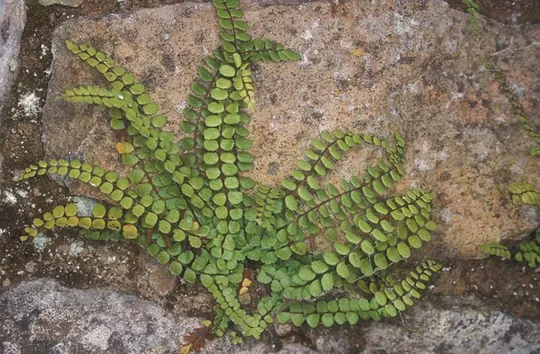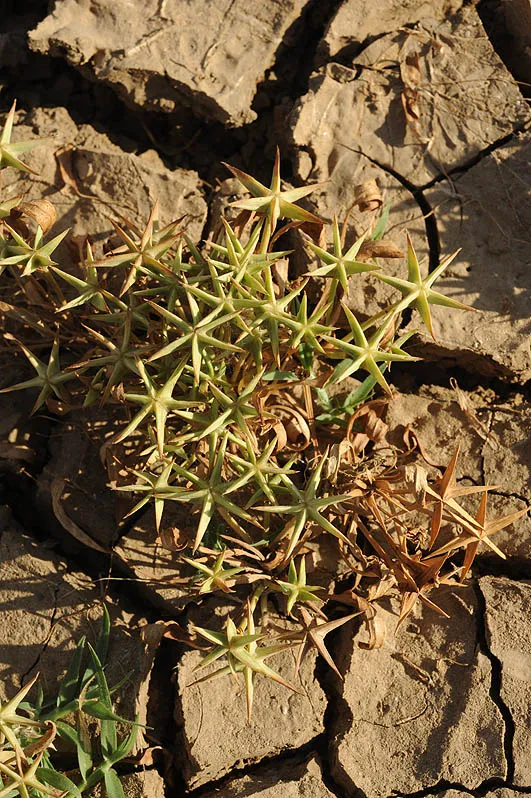Maidenhair Spleenwort
Asplenium trichomanes

Asplenium trichomanes is a perennial herbaceous fern whose rhizome is covered in scales. Its linear leaves are hairless, green all year round, narrow-elongated and up to 35 cm long with a dark reddish-brown petiole. The blade is pinnately dissected, into pairs of opposite elliptical, 1 cm long leaflets. The leaflets have crenate margins and rounded tops. Elongate sporangia are located on the veins on the back of the leaf and give the leaves a bristly look. A. trichomanes can easily be distinguished from other ferns in Israel and Europe by its distinctive leaves: the leaflets are arranged in ordered pairs along the axis of the leaf. Its general appearance and leaf shape is similar to A. ceterach. The sporangia are formed in spring and throughout the summer. The spores are carried over great distances by the wind and enabling the establishment of distant, isolated populations.
Asplenium
trichomanes
grows a single region in Israel – in the Golan, at only one location. In
was formerly found in the upper Galilee in the Mount Meron region, but is now extinct.
In
the Golan, the ferns grow in Ramatanya in two shallow trench-like pits, lined
with stones excavated from the northern slope of Tel Ramtanya. In the 1980s,
several hundreds of plants were found there on the pit floors, on damp, clay
basalt soil (Eti Yafe – pers. comm.). Hundreds of prothallia were found at this
spot in 2005, which testifies to the stability of the population for at least
20 years (Saul Beckerman pers. comm.). Yaakov Koach and Yossi Lev-Ari first
collected the species in the upper Galilee, in the Mount Meron region in 1967, from
a sinkhole at the top of the Peki’in Ridge. Asplenium scolopendrium was
also found on its walls (but was mistakenly identified at the time as A. sagittatum
and A. onoptreis). Some of the plants collected in 1967 were sent
to the botanical garden in Tel Aviv and were grown from sporangia in a
greenhouse at Abu Kabir by Yitshak Altizer. Despite all efforts, the species
was not found again in the 1990 rare plant survey conducted in the region.
Soil-poor
rock crevices poor, in shaded, moist and cool areas in caves or cliffs.
The
genus Asplenium includes about 700 fern species whose distribution is
cosmopolitan, in both the temperate and tropical areas. The species in the
genus do not have a characteristic leaf shape, but have a distinctive
collection of sporangia on the leaf underside.
·
The numbers of locations and populations are very small
because the habitat of Asplenium
trichomanes is
unique and rare in Israel – rock crevices in shaded, moist areas – in caves and
pits in cool regions.
·
Distance and accessibility – the location in the upper
Galilee is distant and difficult to access. The location in the Golan is easy
to access.
·
Distribution pattern and disjunction – the population
grows in a very limited area. The populations are very fragmented, but the
ferns are known for their long-range distribution.
·
The species is not globally endangered.
·
It is protected by law by virtue of being a fern.
Asplenium
trichomanes
should be monitored annually in its two known locations and a detailed survey should
be conducted on the Peki’in Ridge to find it again. In addition, plants should
be relocated or grown from spores of the Israeli populations in botanical refuge
gardens. The moist sinkhole at Mount
Peki’in, and perhaps at Pa’ar Cave as well, should be colonized with prothallia
from the Ramatanya population.
The
Ramtanya Ruin should be declared “a location where an exclusive protected
natural asset is present.”
Asplenium trichomanes has a cosmopolitan distribution and is common primarily in temperate
regions in the Northern Hemisphere, in Europe and North America. A. trichomanes
has a disjunct distribution in many additional locations in the world – South
Africa, Japan, Malaysia, Southern Australia and more. In our region, the
species is very common in central and northern Europe. Its distribution density
gradually decreases towards the Mediterranean region. In the Levant, it is very
rare. One of the most isolated and interesting sites where it grows is located
in the Saudi Arabian Mountains.
Asplenium
trichomanes is
a fern found today in only one location in the Golan. It was extinct in the
Mount Meron region and only a small, peripheral population at the edge of its global
distribution remains. It is endangered because in Israel it has only a single
population, in a rare type of habitat.
שמידע, א. 1981. "צורות החיים של צמחי הסלעים בחבל הים-תיכוני בארץ". רתם 2: 4-10.
שמידע, א. ודנין, א. 1981. "צמחי החודש". טבע וארץ כג: 3.
Current Occupancy Map
| 1000 squre meter pixel | 5000 squre meter pixel | 10000 squre meter pixel | |
|---|---|---|---|
| number of observations | 0 | 0 | 0 |
| in total pixels | 0 | 0 | 0 |
| Family | Aspleniaceae |
| Classification | On the endangered species list |
| Ecosystem | Mediterranean |
| Chorotype | Euro – Siberian |
| Conservation Site | Ramtanya in Central Golan and Huta cave at the top of Peki’in Rigde |
| Rarity |
1
6
6
|
|---|---|
| Vulnerability |
0
0
4
|
| Attractiveness |
0
0
4
|
| Endemism |
0
0
4
|
| Red number |
1
3.2
10
|
| Peripherality | 0 |
| IUCN category | DD EW EX LC CR EN VU NT |
| Threat Definition according to the red book | Vulnerable |
 Based on:
Based on:






